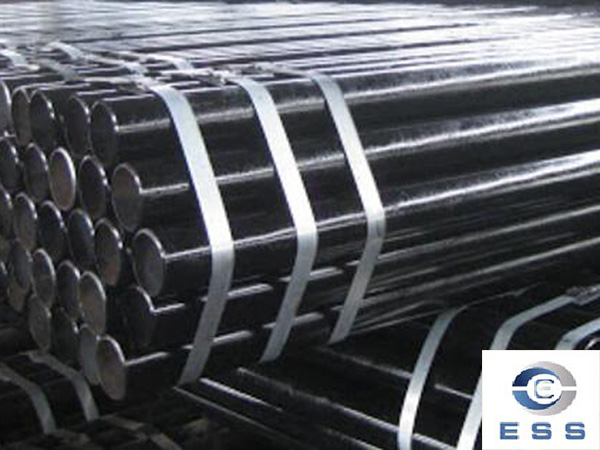Surface treatment of
seamless carbon steel pipe
1, Tool rust removal
Mainly use steel brush and other tools to polish the steel surface, can remove loose or warped oxide skin, rust, welding slag, etc. Manual tools can reach Sa2 level, power tools can reach Sa3 level, if the steel surface is firmly attached to iron sheet, tool rust removal effect is not ideal, can not meet the anti-corrosion construction requirements of anchor grain depth.
2, Clean
The use of solvent, emulsion cleaning steel surface, in order to remove oil, grease, dust, lubricant and similar organic matter, but it can not remove steel surface rust, oxide, solder, so it is only used as an auxiliary means in anti-corrosion production.
3, Pickling
Generally, two methods of chemical and electrolysis are used for
pickling treatment. Only chemical pickling is used for pipeline corrosion prevention, which can remove oxide skin, rust and old coating, and sometimes it can be used as a retreatment after sandblasting and rust removal. Although chemical cleaning can make the surface reach a certain degree of cleanliness and roughness, but its anchor grain is shallow, and easy to cause pollution to the environment.

4, Spray (throw) rust removal
Spray (cast) shot derusting spray is driven by high-power motor (cast) shoot high-speed rotating blades, make steel grit, steel shot, segment, minerals and other abrasive wire under the action of centrifugal force on steel pipe surface spray (cast) processing, not only can thoroughly remove rust, oxides and dirt, and steel pipe under the action of abrasive violent impact and friction, also can achieve the required uniform roughness.
Spraying (throwing) can not only expand the physical adsorption of the pipe surface, but also enhance the mechanical adhesion between the anticorrosive layer and the pipe surface. Therefore, spraying (throwing) rust removal is the ideal way of pipeline
corrosion removal. Generally speaking, shot blasting (sand) rust removal is mainly used for pipe inner surface treatment, shot blasting (sand) rust removal is mainly used for pipe outer surface treatment. Several problems should be paid attention to when spraying (throwing) rust removal.
4.1 Rust removal grade
For the construction process of epoxy, ethylene, phenolic and other anticorrosive coatings commonly used for carbon steel
seamless steel pipe, the surface of the steel tubes is generally required to reach near white grade (Sa2.5). It has been proved that almost all the oxidized skin, rust and other dirt can be removed by using this type of derusting grade, and the anchor grain depth can reach 40~100μm, which fully meets the adhesion requirements of the anticorrosive layer and the steel pipe. The spraying (throwing) derusting process can reach the near white grade (Sa2.5) technical condition with low operating cost and stable and reliable quality.
4.2 Spray (throw) abrasive
In order to achieve the ideal effect of rust removal, abrasive should be selected according to the hardness of the steel pipe surface, the original degree of rust, the required surface roughness, coating type, etc. For single epoxy, two or three layers of polyethylene coating, the use of abrasive sand and steel shot mixture is easier to achieve the ideal effect of rust removal. The steel shot has the effect of strengthening the steel surface, while the steel sand has the effect of etching the steel surface. The abrasive mixture of steel sand and steel shot (the
hardness of steel shot is usually 40 ~ 50HRC, and the hardness of steel sand is 50 ~ 60HRC, which can be used on a variety of steel surfaces, even on the surface of C and D grade rust, rust removal effect is very good.
4.3 Particle size and ratio of abrasive
In order to obtain better uniform cleanliness and roughness distribution, the abrasive particle size and proportion design is very important. If the roughness is too large, the anticorrosion layer will become thin at the peak of anchor grain. At the same time, because the anchor grain is too deep, the anti-corrosion layer is easy to form bubbles in the anti-corrosion process, which seriously affects the performance of the anti-corrosion layer.
Too small roughness will cause the adhesion and impact strength of the anticorrosive layer to decrease. For serious internal pitting, it is not only by high-strength impact of large abrasive particles, but also by grinding away corrosion products of small particles to achieve the cleaning effect. At the same time, reasonable proportioning design can not only slow down the wear of abrasive to pipeline and nozzle (blade), but also greatly improve the utilization rate of abrasive. Usually, the particle size of the steel shot is 0.8 ~ 1.3mm, and the particle size of the steel sand is 0.4 ~ 1.0mm, of which 0.5 ~ 1.0mm is the main component. Sand shot ratio is generally 5 ~ 8.
It should be noted that in practice, the ideal ratio of steel sand to steel shot in abrasive is difficult to achieve, because hard and brittle steel sand has a higher rate of breakage than steel shot. Therefore, in the operation should be continuously sampled and tested mixed abrasive, according to the particle size distribution, to the derusting machine mixed with new abrasive, and mixed with new abrasive, the number of steel sand to account for the main 35CrMo alloy pipe, 35CrMo steel pipe.
Read more : seamless vs welded pipe













 Eastern Steel Manufacturing Co.,Ltd not only improve product production and sales services, but also provide additional value-added services. As long as you need, we can complete your specific needs together.
Eastern Steel Manufacturing Co.,Ltd not only improve product production and sales services, but also provide additional value-added services. As long as you need, we can complete your specific needs together.










